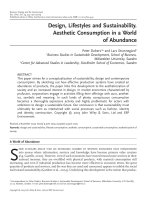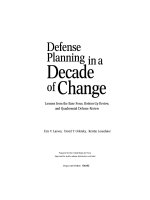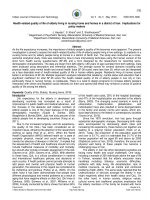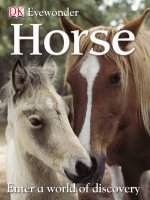3 5 living things in a world of change (life sciences)
Bạn đang xem bản rút gọn của tài liệu. Xem và tải ngay bản đầy đủ của tài liệu tại đây (4.17 MB, 12 trang )
Life Sciences
Standards
Preview
Standard Set 3. Life Sciences
3. Adaptations in physical structure or
behavior may improve an organism’s
chance for survival. As a basis for
understanding this concept:
3.c. Students know living things cause
changes in the environment in which
they live: some of these changes are
detrimental to the organism or other
organisms, and some are beneficial.
3.d. Students know when the
environment changes, some plants and
animals survive and reproduce; others
die or move to new locations.
3.e. Students know that some kinds
of organisms that once lived on Earth
have completely disappeared and that
some of those resembled others that
are alive today.
by Trish West
Genre
Nonfiction
Comprehension Skill
Make Inferences
Text Features
• Captions
• Glossary
Science Content
Changing
Environments
Scott Foresman Science 3.5
ISBN 0-328-23530-X
ì<(sk$m)=cdfdai< +^-Ä-U-Ä-U
Vocabulary
competition
extinct
fossil
habitat
by Trish West
Picture Credits
Illustration
19 Peter Bollinger
Photographs
Every effort has been made to secure permission and provide appropriate credit for photographic material. The
publisher deeply regrets any omission and pledges to correct errors called to its attention in subsequent editions.
Unless otherwise acknowledged, all photographs are the copyright of Dorling Kindersley, a division of Pearson.
Photo locators denoted as follows: Top (T), Center (C), Bottom (B), Left (L), Right (R), Background (Bkgd).
7 ©Paal Hermansen/NHPA Limited; 9 ©Ed Bock/Corbis; 15 (L) ©Larry Ulrich/DRK Photo, (R)Neg./Transparency No.
K13073. Courtesy Dept. of Library Services/American Museum of Natural History; 16 ©The Natural History Museum,
London; 18 ©Ross M. Horowitz/Getty Images
ISBN: 0-328-23530-X
Copyright © Pearson Education, Inc. All Rights Reserved. Printed in the United States of America.
This publication is protected by Copyright, and permission should be obtained from the publisher prior to any
prohibited reproduction, storage in a retrieval system, or transmission in any form by any means, electronic,
mechanical, photocopying, recording, or likewise. For information regarding permission(s), write to
Permissions Department, Scott Foresman, 1900 East Lake Avenue, Glenview, Illinois 60025.
1 2 3 4 5 6 7 8 9 10 V010 13 12 11 10 09 08 07 06
How do living
things change their
environment?
Change can tip the balance. For example, trees
in a forest need sunlight to grow. If there are too
many trees, they can’t all get sunlight. Some trees
may die. When two or more living things need the
same things, they are in competition.
Changing the Environment
A habitat is a place where a living thing
makes its home. Living things get what they need
from their habitat.
A habitat is like a balance. On one side of the
balance are the things that live in the habitat.
On the other side are the things that the habitat
provides. If the balance has equal things on both
sides, plants and animals can live and grow there.
Sunlight helps these young
trees grow.
2
3
Beavers Causing Change
Animals change their environment by building
Humans Causing Change
People need shelter just as other living things
homes. A beaver cuts down trees with its sharp
do. People make room for their homes. They may
teeth. It builds a dam. The dam holds back moving
cut down forests for wood. They may also plow
water. The blocked water forms a pond for the
up grasslands for farms. These changes affect the
beaver’s home.
environment. Sometimes people and animals
The dam is good for animals that like to live
compete for living space.
in still water. It gives them more places to live.
This change is not good for animals that live in
moving water.
This change affects plants too. The trees that are
cut down no longer shade the area. Other plants
get more sunlight. They have room to grow.
Beavers build homes and dams from mud and
sticks. The beavers change the environment.
People have changed the environment by
building homes and farms. They may now be
competing with animals for space.
4
5
Plants and Algae Causing Change
Changes can help some living things and hurt
A Pattern of Change
Some changes repeat in a cycle. For example,
others. For example, someone brought purple
small mammals called lemmings eat tundra
loosestrife to the United States. Animals here don’t
plants. When there is a lot of food, there are more
eat it. It keeps growing in more places. Now there is
lemmings. After lemmings eat most of the plants,
less room for plants that lived here first.
there is less food. Many lemmings leave. Then the
Fertilizers also change the environment. Farmers
use them to help their crops grow. Some fertilizers
plants can grow back. This finishes the cycle. The
cycle is then repeated.
wash into streams. Tiny algae live there. Fertilizers
help the algae grow. If they grow too much, the
algae block sunlight. Some algae die. Tiny living
Lemmings cause changes that
can repeat in a cycle.
things that eat the dead algae grow in number.
They use up the oxygen that fish need. Fish die or
move to a new habitat.
Purple loosestrife
compete with
other plants.
6
7
How do changes in
the environment
affect living things?
Too Little Water
Periods of dry weather change environments.
People can also make places dry. They may use too
A place may get drier over thousands of years.
Shrubs and grasses adapted to using less water
may replace trees that need more water. The
animals in a place can also change. Animals that
use shrubs and grasses for homes and food replace
animals that use trees.
Too Much Water
Living things need water. However, too much
much water for their homes and farms. Then lakes
water all at once can change an environment.
and streams will not have enough water for animals
Storms can cause floods. Floods wash away
and plants. Animals die or move away.
animals’ homes. Floods also wash away soil and
plants. Floods spread thick blankets of mud.
During a dry season, some plants can
survive by using less water. Others die.
Animals may die, live, or move away.
When the Mississippi River floods, it can
carry seeds and mud to new places.
8
9
Volcanic Eruption
In the spring of 1980, Mt. St. Helens erupted in
After the Eruption
Not all living things on Mt. St. Helens died during
Washington State. One side of the volcano broke
the eruption. Seeds hidden in the soil sprouted and
away. Hot rocks and gases melted snow and ice.
grew. Wind blew seeds from other places.
The area was flooded. The volcano shot out a cloud
of ash. Winds carried the ash around the world.
The blast changed the environment. Mud
Animals that lived underground also survived.
These ants, spiders, mice, and gophers were
protected from the blast. Birds came back to live in
covered huge areas. In some places, ash piled
dead trees. Mice, shrews, and voles also returned.
up a meter thick. The forests on Mt. St. Helens
The weasels that ate these animals returned, and
were destroyed.
so did large elk.
Each change in the environment brought
back different kinds of plants and animals to the
mountain. The environment won’t be the same as
it was for a long time. But the mountain is filled
with life again.
Only a few plants
survived the eruption
of Mt. St. Helens.
10
11
Wildfire
Lightning can strike a tree in a forest. This can
Animals have fewer places to hide in a burnt
forest. Their enemies can hunt them more easily.
cause a wildfire. The fire races through the forest.
Birds can find seeds on the open ground. New seeds
Dead brush and small plants burn. Some trees
are carried in by wind and animals. Plants that
with thick bark survive. A fire brings big changes
are adapted to strong sunlight grow. They prepare
to a forest.
habitat that trees need to grow. Soon, the forest
Forest fires bring both harmful and helpful
returns.
changes. Animals and plants die. They lose their
homes. However, fire clears the forest of dead wood.
A forest fire can get as hot as 800°C.
It also makes more living space. Ash makes the
soil healthy for plants to grow. Fire often creates
habitat for more kinds of living things.
Before a fire, trees and other plants
crowd the forest.
12
13
How do living
things compare to
those of long ago?
Fossils
What Fossils Show
Fossils hold clues about extinct plants and
animals. Fossils tell something about the
environments these plants and animals once lived
in. Fossils show changes in those environments.
Fossils help show how extinct plants and animals
are similar to living ones.
An environment may change more quickly
than a kind of living thing can adapt. The change
can cause these plants and animals to go extinct,
or to no longer be living on Earth.
Many plants and animals have become extinct
over time. They no longer exist, but we can study
the fossils that are left behind. A fossil is the
This is a fossil of a
fern that lived 350
million years ago.
This fern looks like many
extinct ferns. It grows
today in Redwood National
Park in California.
remains or mark of a living thing from long ago.
This is the fossil
of an extinct
flying animal.
14
15
Changes in Plants over Time
Plant fossils show us that the first plants were
One group of flowering plants that has survived
are magnolias. When they first appeared, the
different. They did not have cones or flowers. Many
world was warm and wet. Magnolia trees had large
of them looked like today’s ferns. As Earth changed
flowers and leaves that they kept all year. Today,
over time, so did the first plants. Trees that made
magnolias like this are still alive.
cones appeared. Then flowering plants appeared.
Many of these are no longer living.
Some places where magnolias live have cold
winters now. The magnolias in these places lose
their leaves in fall. Their leaves and flowers,
however, are still similar to the early magnolias.
The magnolia flower hasn’t changed for 100
Today, many magnolia
leaves still look a lot like
this fossil.
million years!
Some magnolia trees
have flowers that
bloom all at once.
16
17
Changes in Animals over Time
We can use fossils to learn how animals and the
Fossils of Tyrannosaurus rex have been found in
the dry Badlands of South Dakota. This dinosaur
places in which they lived have changed over time.
probably used its sharp teeth to tear meat from the
Animals’ teeth, for example, are adapted to eating
animals it hunted. Other dinosaur fossils found
certain kinds of food. Meat-eating animals have teeth
have grinding teeth. These dinosaurs must have
that cut and tear. Plant-eating animals have teeth
eaten plants.
that grind only. Comparing teeth of living things to
those of dinosaurs shows what dinosaurs ate.
Fossils of trees that lived in swamps have also
been found in the Badlands. The area does not
have many plants today. But all these fossils show
how the Badlands must once have been a warm,
The Badlands in South Dakota used to be warm and
wet all the time. Today they are almost a desert.
wet place with many plants.
Dinosaurs such as this T. rex
have been extinct for about
65 million years.
18
19
Glossary
What did you learn?
1. What does a living thing get from its habitat?
competition when two or more living things
need the same resources
2. What can fossils tell us?
extinct
no longer lives on Earth
3. How can fertilizers change an environment?
fossil
the remains or mark of a living
thing from long ago
habitat
the place where a living thing
makes its home
20
4.
Think about an event that
has changed the environment. It could be a flood, a
drought, a wildfire—even new buildings. Write a
description of how the environment changed. How
were plants, animals, and people affected?
5.
Make Inferences You see a dam made of trees,
sticks, and mud across a stream. A pond has formed
behind the dam. What kind of animal might live
nearby?









